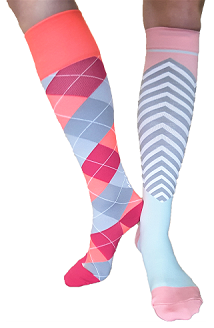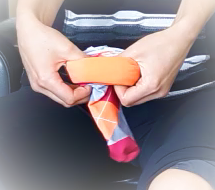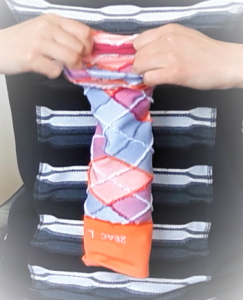
Compression Socks – Happy and Healthy Legs!
How do you know if compression socks are right for you? Do you sit or stand for long periods of time? Do your ankles or legs swell up at the end of the day? Then compression socks may be beneficial! Compression socks are commonly associated with the large veins popping out of the leg, called varicose veins, but there are other benefits as well!
Compression socks do help with varicose veins (spider veins), but also with swelling and to prevent issues later in life. They recirculate the blood to prevent pooling and stretching of valves leading to varicose veins and swelling.
What will I see and feel?
Varicose veins are the visible veins, commonly on the lower and upper legs. As the veins become worse, they start to protrude from the skin. These areas may become achy and painful. Also, look for swelling in the ankles and feet, as gravity tends to pull this swelling down.
There may be swelling at the end of the day without the presence of varicose veins. This may cause achy legs and increase the chances of developing varicose veins. At the end of the day, your shoes may feel tighter than at the beginning of the day. In more severe cases, you may need to loosen the closure on your shoe to allow more room for your foot. Also, look at the cuff of the sock. If there is an impression on your skin when you remove your sock, there is swelling present.
Risk Factors
There are certain factors that increase the risk of developing varicose veins. These are age, weight, low activity level, genetics and sitting or standing for long periods of time. If you have one or more of these risk factors, a mild compression sock may be a good place to start.
Which Compression Socks Should I Choose?
When choosing a compression sock, we look at the length, compression level and size.
To determine the length, look at where the varicose veins are present. The sock should cover the affected veins to provide the proper support. Knee high socks are popular because varicose veins commonly develop in the lower leg, and they are typically the shortest sock you will find with a benefit, therefore the easiest to wear! For prevention, the knee high sock is a great place to start.
The most common compression levels are the 15-20mmHg for prevention and 20-30mmHg for medical reasons. There are also 8-12mmHg and 30-40mmHg compression levels for the other extremes. For any medical reasons, and compression levels at 20-30mmHg or above, talk to your doctor to determine the correct compression level.
Compression socks come in multiple sizes to correctly fit many legs. To determine the correct size, measurements to the circumference and the length of the leg are taken. Find a clinic who will take the proper measurements to find the best fit!
Types
Compression socks have come a long way in fashion. There are multiple colours and styles to fit all kinds of situations and personalities! There are socks like leggings, nylon, sport style, cotton, business style, any many more.
 How to Wear Compression Socks
How to Wear Compression Socks
There are easier and harder ways to wear compression socks. If you bunch up the sock at the ankle and try to pull the sock on, all the compression is concentrated in one area. With all this compression, it is very hard to pull the sock over the heel.

The easiest way to put on a compression sock is to grab just past the heel on the inside of the sock and pull the sock out to prevent all compression in one area. Once most of the sock has been turned inside out, put the foot part of the sock on, grab the ends of the sock, and pull the rest up the leg. The sock should slide on past the foot and onto the leg with less effort.
Make sure there are no creases along the sock, as this may cut off circulation and cause pain. Also, the sock should not bunch at the top. If this occurs, pull the fabric down the leg to distribute the fabric over a smaller area.
For those who have issues trying to wear compression socks, there are wraps available. This is an easier way to wear compression.
How Long Do Compression Socks Last?
The sock does stretch out over time, which decreases the amount of compression. The length of time compression socks will last depend on how frequently they are worn and washed. This is generally between 6-12 months.
Most compression socks can put in the regular wash and dryer, but to help them last longer we recommend a delicate wash and hang to dry.
For videos about compression socks, use this link! If you have any further questions, feel free to contact us!

You must be logged in to post a comment.